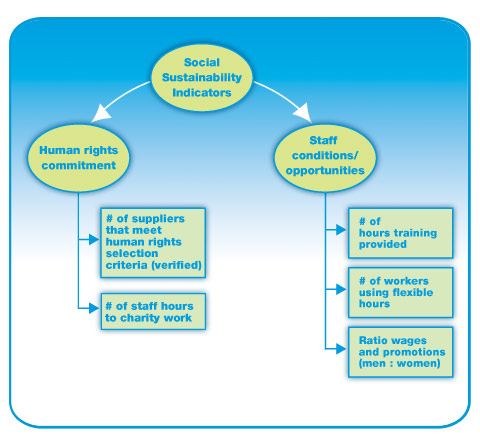Most businesses are familiar with setting goals, performance indicators and metrics; and you can apply these practices to sustainability.
Sustainability indicators allow you to focus your efforts on specific areas of sustainability and to measure your performance and improvements. They can help you to identify and prioritise your sustainability activities. Deciding what you are going to target will help you to develop your procedures for measuring and reporting and environmental management.
In some cases what you measure will be an indicator of your performance rather than being a direct measure. This is often the case in social sustainability. While environmental damage or reduction in waste can often be readily seen and measured your business impact on the people in the local community may be harder to quantify.
In addition to any regulatory requirements it makes sense to choose indicators that are relevant to your business activities and goals. However there is no point setting an indicator that cannot be measured so this needs to be built in to your decision making process. When you identify your sustainability strategies and activities make sure they are SMART – specific, measurable, achievable, realistic and timely. This will help you to think about how to measure them.
You may be able to think of indicators that reflect more than one aspect of sustainability or that sit across several business activities. You can also refer to voluntary standards, frameworks and codes of practice to get ideas. The published sustainability reports from other enterprises can also be a source of information.
See About quantifying benefits and costs and About metrics.
Environmental sustainability indicators
You are probably already monitoring the costs associated with your energy and fuel consumption and your waste removal. However, if you are like most organisations, you may know this for the whole business but not for individual sections or operations.
When you invest in efficiency improvement projects it is critical to measure and monitor so that you know whether the investment is worthwhile. Most savings will come from the sum of changes to individual operations or work areas; so it is important to measure and monitor work areas and not just the whole. You will need to identify the right factors, measure your starting point and monitor whether your improvement activities have made a difference.
This can be straightforward if you have a simple process or want to focus on a single factor. However other environmental factors may require more complex measurement and calculations. These include mass and energy balancing to identify where losses occur within a process and quantify the losses, calculating embedded carbon and carbon equivalents and National Pollutant Inventory calculations.
Indicators used for environmental sustainability include:
- Resource consumption rates
- Embedded or embodied carbon
- Quality of air, soil and water
- Changes in local ecosystems, flora and fauna
- Direct or indirect emissions converted to carbon dioxide equivalents
- Loss of energy and/or materials calculated by mass and/or energy balancing.
Social sustainability indicators
Identifying social sustainability factors to measure can be challenging.
Even where there are no direct measures you may be able to find ‘indicators’ that you think reflect or represent an aspect of social sustainability.
Surveys are sometimes used to measure the organisation’s culture and its image in the community. Seeking involvement in community groups will often also provide a measure of the organisation’s image in the community.
Indicators that might be used include:
- Rate of complaints and how they have been addressed
- Number of corruption charges or industrial relations actions
- Number of safety incidents and environmental accidents with an impact on the community or workers
- Record of human rights and child labour complaints
- Employee turnover rates and costs
- Customer satisfaction (via surveys or tracking feedback and complaints)
- Number of community consultations, number of attendees, issues raised and addressed
- Number of and outcomes from community engagement initiatives
- Level of contribution to charities – donations and/or employee days contributed
- Column inches in local or state newspapers (and whether it was good or bad).

Economic sustainability indicators
Your business probably has well established financial performance indicators and metrics. Some of them may be defined by financial regulations such as the Australian Securities and Investments Commission (ASIC) requirements for incorporated entities and the Australian Tax Office requirements. Others may be defined by the accounting standard you are following.
Others measures that may be relevant include (overall and by product group):
- Value stream/customer value
- Waste
- Business efficiency
- Productivity
- Bottom line – single or triple
- Rate of return and payback periods for capital investments
- Cost of goods sold
- Inventory turns
- EBIT (Earnings Before Interest and Tax)
- Gross and net profits
- Liquidity
- Time interest earned
- Cost of servicing capital.

